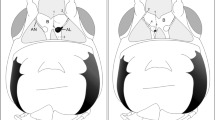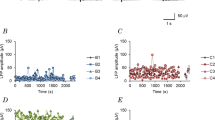Summary
Physiologically identified primary electroreceptive afferents in the gymnotiform fish,Eigenmannia, were labelled by intracellular injection of horseradish peroxidase (HRP) in order to determine their termination sites in the posterior lateral line lobe (PLLL) (Fig. 1). For each terminal field we mapped the location of the associated receptor pore on the body surface and found:
-
1)
Ampullary units project in a somatotopically ordered manner to the medial PLLL.
-
2)
Tuberous units, both P- and T-types, project in a somatotopically ordered manner to three separate regions of the PLLL, called central-medial, central-lateral and lateral (Figs. 2–4). Each tuberous unit projects to all three maps and the projections of P- and T-units are in somatotopic register.
In addition to electroreceptive units, mechanoreceptive units were also encountered in the anterior lateral line nerve ganglion, but their central projections were found outside of the PLLL, in the anterior lateral line lobe (ALLL) and in the eminentia granularis. This finding is in accordance with the notion of modality-specific separation of central projections, forwarded by Maler et al. (1974).
Tuberous electroreceptive afferents have larger somata and faster nerve conduction the further their receptor pores are located towards the tail end of the body (Fig. 5, 6). The faster nerve conduction of afferents from more distant regions of the body surface minimizes temporal disparity in the arrival of spikes linked to synchronous electrical events in widely separated regions of the body surface.
Similar content being viewed by others

Abbreviations
- ALLL :
-
anterior lateral line lobe
- EOD :
-
electric organ discharge
- HRP :
-
horseradish peroxidase
- PLLL :
-
posterior lateral line lobe
References
Bastian J, Heiligenberg W (1980) Neural correlates of the jamming avoidance response inEigenmannia. J Comp Physiol 136:135–152
Bell CC, Russell CJ (1978) Termination of electroreceptor and mechanical lateral line afferents in the mormyrid acousticolateral area. J Comp Neurol 182:367–382
Bell CC, Finger TE, Russell CJ (1981) Central connections of the posterior lateral line lobe in mormyrid fish. Exp Brain Res 42:9–22
Bennett MVL (1967) Mechanism of electroreception. In: Cahn P (ed) Lateral line detectors, Indiana University Press, Bloomington, pp 313–393
Bennett MVL (1971) Electric organs. In: Hoar WS, Randall DJ (eds) Fish physiology, vol V. Academic Press, New York, pp 347–491
Bullock TH (1974) General introduction to electroreceptors and other specialized receptors in lower vertebrates. In: Fessard A (ed) Handbook of sensory physiology, vol III/3. Springer, Berlin Heidelberg New York, pp 1–12
Carr CE, Matsubara J (1981) Central projections of the octavolateralis nerves in gymnotiform fish. Abstract 28.10, Soc Neurosci, Los Angeles
Carr CE, Maler L, Sas E (1982) Peripheral organization and central projections of the electrosensory nerves in gymnotiform fish. J Comp Neurol (in press)
Heiligenberg W, Bastian J (1980) The control ofEigenmannia's pacemaker by distributed evaluation of electroreceptive afferences. J Comp Physiol 136:113–133
Heiligenberg W, Partridge BL (1981) How electroreceptors encode JAR-eliciting stimulus regimes: Reading trajectories in a phase-amplitude plane. J Comp Physiol 142:295–308
Heiligenberg W, Baker C, Matsubara J (1978) The jamming avoidance response inEigenmannia revisited: The structure of a neuronal democracy. J Comp Physiol 127:267–286
Hopkins C (1976) Stimulus filtering and electroreception: Tuberous electroreceptors in three species of gymnotoid fish. J Comp Physiol 111:171–208
Katz L, Gurney M (1981) Auditory responses in the zebra finch's motor system for song. Brain Res 221:192–197
Maler L (1979) The posterior lateral line lobe of certain gymnotoid fish: Quantitative light microscopy. J Comp Neurol 183:323–364
Maler L, Sas E (1982) Organization of descending projections to the posterior lateral line lobe. I: Nucleus praeeminentialis. J Comp Neurol (in press)
Maler L, Finger T, Karten HJ (1974) Differential projections of ordinary lateral line and electroreceptors in the gymnotoid fish,Apteronotus albifrons. J Comp Neurol 158:363–382
Maler L, Sas E, Rogers J (1981) The cytology of the posterior lateral line lobe of high-frequency weakly electric fish (Gymnotoidei): Dendritic differentiation and synaptic specificity in a simple cortex. J Comp Neurol 195:87–139
Scheich H, Bullock THE, Hamstra RH (1973) Coding properties of two classes of afferent nerve fibers: High frequency electroreceptors in the electric fish,Eigenmannia virescens. J Neurophysiol 36:39–60
Stewart WW (1978) Functional connections between cells as revealed by dye-coupling with a highly fluorescent naphthalimid tracer. Cell 14:741–759
Szabo T (1974) Anatomy of the specialized lateral line organs of electroreception. In: Fessard A (ed) Handbook of sensory physiology, vol III/3. Springer, Berlin Heidelberg New York, pp 13–58
Triller A, Korn H (1981) Interneuronal transfer of horseradish peroxidase associated with exo-endocytotic activity on adjacent membranes. Exp Brain Res 43:233–236
Viancour TA (1979) Electroreceptors of a weakly electric fish. I. Characterization of tuberous receptor organ tuning. J Comp Physiol 133:317–325
Author information
Authors and Affiliations
Rights and permissions
About this article
Cite this article
Heiligenberg, W., Dye, J. Labelling of electroreceptive afferents in a gymnotoid fish by intracellular injection of HRP: The mystery of multiple maps. J. Comp. Physiol. 148, 287–296 (1982). https://doi.org/10.1007/BF00679013
Accepted:
Issue Date:
DOI: https://doi.org/10.1007/BF00679013



